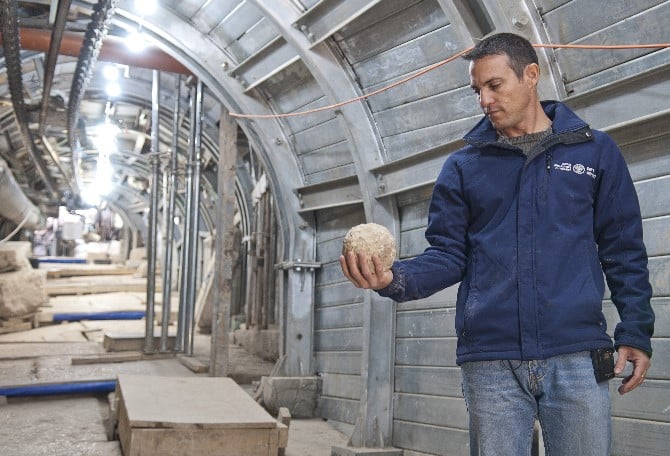Nachshon Zanton, director of the excavation of the street that led to the Temple: “2000 years after the destruction of Jerusalem and fifty years since its liberation, we are returning to the cisterns, the market, and the square of Jerusalem on the eve of its destruction. I don’t think Naomi Shemer ever dreamed that we would get to return to the Jerusalem of the time of the Second Temple.”
Among other things, arrowheads and catapult stones are presented for the first time.
On the occasion of Jerusalem Day and the jubilee celebrations for the unification of the city, the Antiquities Authority and the Nature and Parks Authority in the City of David, within the boundaries of the national park surrounding the walls of Jerusalem, reveal evidence of the battle for Jerusalem from 2,000 years ago, on the eve of the destruction of the Second Temple. In the main street that went up from the city gates and the Pool of Siloam area to the Temple, and was excavated during the last few years with the funding of the ‘City of David’ (Al-D) association, arrowheads and gallstones were discovered. These findings tell the story of the last battle between the Roman forces and the Jewish rebels who fortified themselves in the city – a battle at the end of which Jerusalem was destroyed. This battle is described by the historian, Josephus Flavius: “The next day the Romans battled the brigands from the lower city and set fire to everything up to Siloam”.
According to Nachshon Zanton and Moran Hajbi, directors of the excavation on stepped street on behalf of the Antiquities Authority: “For the first time, Josephus’ descriptions of the battle in the Lower City intersect with evidence that was uncovered in the field in a distinct and chilling way. In the excavation, catapult stones were discovered that were fired by war machines that bombarded Jerusalem during the Roman siege of city. We also found arrowheads, which were used by the Jewish rebels in the hard battles against the Roman legions, just as Josephus describes.”
So far, excavations have revealed a street section about 100 meters long and 7.5 meters wide, paved with large stone slabs – as was customary in monumental construction throughout the Roman Empire. The archaeological excavations in the street use advanced and pioneering research methods, the results of which so far strengthen the understanding that King Herod the Great was not solely responsible for the major construction works of Jerusalem at the end of the Second Temple: the latest research shows that the street was built after the days of Herod, under the auspices of the Roman Commissioners of Jerusalem, and apparently in the days of the Roman commissioner, Pontius Pilate, who is also known for being the one who condemned Jesus to crucifixion.
“2000 years after the destruction of Jerusalem and fifty years since its liberation,” say the archaeologists, “we are returning to the cisterns, the market and the square of Jerusalem on the eve of its destruction. Naomi Shemer certainly never dreamed that we would get to rediscover the Jerusalem of the days of the Second Temple.”
According to Dr. Yuval Baruch, an archaeologist for the Jerusalem area at the Antiquities Authority: “We intend to uncover the street in its full length and width within about 5 years, thus essentially completing the excavation of this unique site, which has been attracting the attention of archaeologists from around the world for around 100 years. In fact, the current excavations in the City of David can be regarded as the natural location of previous archaeological excavations at the site, which were begun by European and American researchers. About four years ago, the archaeological excavations along the length of the street were renewed, and this time – with the aim of revealing its full length and width.” According to Baruch, “upon completion of the excavations, the remains of the street will be preserved, and it will be developed and prepared in order to receive the thousands of visitors who will walk along it.”
Recognizing the importance of the site and the find, the researchers of the Antiquities Authority chose to adopt advanced and pioneering research methods from the fields of natural sciences, biology and geology in conducting their excavation. The combination of these advanced methods places the excavation of the stepped street in the City of David as an exceptional excavation, both in terms of its scientific quality and importance
to the development of archaeological research in Jerusalem and in Israel in general, and they allow researchers to deal with questions that have not yet been investigated. The current excavations also focus on uncovering the edges of the street, and the shops that flanked it. The excavations reveal findings that will allow researchers to answer intriguing questions, such as: What did the main road that led to the temple look like? What was the urban character of the lower city that stretched along the sides of the magnificent road? What did they eat in Jerusalem during the difficult days of the siege? In order to answer these questions, a multidisciplinary study is being carried out, as well as a wet and rigorous screening at the screening site at the Emek Tzurim National Park, where even the smallest find is collected.
It seems that we are close to the day when it will be possible, for the first time, to walk along one of the main streets of ancient Jerusalem, to stand to behold it, and to obtain answers to fascinating historical questions that have been asked for 100 years, related to the history of Jerusalem at the time of the Second Temple at the height of its glory, and at the time of its destruction.




